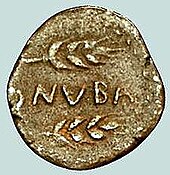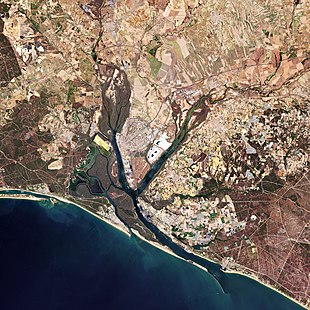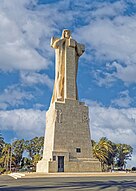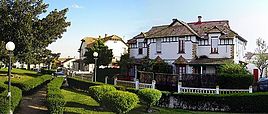Huelva
Huelva | |
|---|---|
| Motto: Portus Maris et Terrae Custodia | |
 Location of Huelva | |
| Coordinates:37°15′N6°57′W/ 37.250°N 6.950°W | |
| Country | Spain |
| Region | Andalusia |
| Province | Huelva |
| Founded | c. 10th–9thcentury BC |
| Government | |
| • Mayor | Pilar Miranda Plata (PP) |
| Area | |
| • Total | 149 km2(58 sq mi) |
| Elevation | 54 m (177 ft) |
| Population (2018)[1] | |
| • Total | 144,258 |
| • Density | 970/km2(2,500/sq mi) |
| Demonym(s) | onubense, (colloquially) choquero/a |
| Time zone | UTC+1(CET) |
| • Summer (DST) | UTC+2(CEST) |
| Postal code | 21001 and others |
| Website | Official website |
Huelva(US:/ˈhwɛlvə/WHEL-və,[2][3]Spanish:[ˈwelβa],locally[ˈɡweɾβa][4]) is a municipality ofSpainand the capital of theprovince of Huelva,in theautonomous communityofAndalusia.Located in the southwest of theIberian Peninsula,it sits between the estuaries of theOdielandTintorivers on the Atlantic coast of theGulf of Cádiz.According to the 2010 census, the city had a population of 149,410.
While the existence of an earlier pre-Phoenician settlement within the current urban limits sincec. 1250 BChas been tentatively defended by scholars,Phoeniciansestablished a stable colony roughly by the 9th century BC.[5]Modern economic activity conformed to copper and pyrite extraction upstream funded by British capital and to the role ofits port,as well as with the later development of a petrochemical industry.
Huelva is home toRecreativo de Huelva,the oldest football club in Spain.
History
[edit]Protohistory
[edit]At least up to the 1980s and 1990s, the mainstream historians' view was that Huelva began as anautochthonousTartessiansettlement (possibly the very same Tartessos mentioned in Greek sources); later opinions have held that it was a multi-ethnic enclave, mi xing natives with peoples with a mainly Phoenician, and later Greek, extraction.[6]However, following the finding of Phoenician archaeological materials in the Méndez Núñez-Las Monjas site, the chronology as to the Phoenician presence was reassessed. The evidence favours solely viewing Huelva-Onoba as a very early Phoenician colony, a development which was parallel to a certain "dismantling" of the idea of Tartessos as a mainly autochthonous archaeological culture, even though the tentative identification of Huelva with Tartessos was not discarded, but rather kept.[7]Tartessos has also been identified with the biblicalTarshish.[8]
First contacts with the localPhoenicianpresence have been hypothesised to have taken place as early as 1015 to 975 BCE.[9]However, remains such as those found in the Méndez Núñez-Las Monjas go so far as to show a likely Phoenician settlement of the9th century BCE,especially to resemble a founding date of aTyriansettlement from the reign ofIthobaal Ibetween 875 and 850,[further explanation needed][9]although the Méndez Núñez-Las Monjas' archaeological finds have been brought forward as evidence of a 10th-century BCE founding chronology in the era ofHiram I(c. 975–950).[9][10]The outpost was presumably populated mainly by continental Phoenicians, with some possible addition of the likes ofEteocypriots,Cypriot Phoenicians and Sardinian Phoenicians.[11]
As a Phoenician outpost, it facilitated local exports such assilver,copper,purple dyeandsalted fish,while it also served as node in the trade routes connecting the Northern Atlantic, the Southern Atlantic and the Mediterranean.[12]Population notably increased from the mid-8th century BCE onward, possibly connected to the arrival of refugees fleeing fromTiglath-Pileser IIIand, overall, from the economic crisis and social unrest induced by theAssyriansubjugation of the Levant.[13]
It was calledʿunʿu baʿl( "Baal's fort ") by the Phoenicians, which in mostGreektexts corrupted toὌνοβα(Onoba).[citation needed]The Tartessian world entered a crisis in the 6th century BCE.[14]The transition from the Tartessian period to the ensuingTurdetaniperiod was presumably slow and not traumatic, degenerating from an economy based on mining to a new one focused on the trade of agricultural and fishing products.[15]It was in the hands of theTurdetaniat the time of conquest byRome,and before the conquest, it issued silver coins withIberianlettering.
Antiquity
[edit]
The place was called bothOnoba Æstuaria[16]orOnuba(used on coinage) during Roman times, or, simply,Onoba.[17]It was put in the Roman province ofHispania Bætica.According to theAntonine Itinerary:it was a maritime town between the Anas, (modernGuadiana) and Bætis (modernGuadalquivir); it was on the estuary of the Luxia (modernOdiel), and on the road from the mouth of the Anas to Augusta Emerita (modernMérida).[18]There are still some Roman remains. Huelva hosted a mint; and many coins have been found there bearing the name of the town as Onuba.[19]
Middle Ages
[edit]Soon after the beginning of theUmayyad invasion of the Iberian Peninsulain 711,Onubawas seized by the troops ofMusa ibn Nusayrby April 712.[20]Within a few decades, to both the broader Islamic world and the conquered locals, the town's name had corrupted to ولبة (Walba).
During thefitna of al-Andalusa weak and ephemeraltaifaemerged following the demise of localUmayyad control:thebakrid,from 1012 to 1051. In the latter year, it was annexed by the more powerfulTaifa of Seville,[21]to be later occupied by theAlmoravidsin 1091. By 1262, Huelva—then part of theTaifa of Niebla—was taken byAlfonso X of Castile.[21][22]From 1265 onward, Huelva enjoyed an exemption from theportazgotribute, aportage tax.[23]
Following the Christian conquest, the town became aroyal demesnefor a short time, until it was ceded in Lordship to AdmiralJuan Mathé de la Lunain 1293 bySancho IV of Castile.[24]After a period during which Huelva was probably controlled by Seville, thetenenciaof the lordship was passed to several lords, includingAlonso Meléndez de Guzmán—brother ofEleanor de Guzmán—(in 1338) andJuan Alfonso de la Cerda(c. 1344).[25]Huelva, again arealengofor a short time during the reign ofPeter I,saw its privileges confirmed and was granted the right to choose thealcaldeand thealguacilin 1351.[26]The lordship was soon given to the king's mistress,María de Padilla.[25]
Early modern history
[edit]
It suffered substantial damage in the1755 Lisbon earthquake.
Huelva became a leading fishing town in Andalusia in the 16th century (thriving in thesardineandtunamarkets).[27]The town became a provincial capital in 1833.[27]
Modern history
[edit]Mines in the countryside still send copper andpyritetoHuelva's portfor export. From about 1873, the major mining company has beenRio Tinto.[28]

Huelva acquired the status of city (ciudad) by means of a royal decree on 17 September 1876.[29]
The ore-smelting caused severesulfur dioxidepollution and was frequently met by the protests of local farmers, peasants and miners, allied under the anarchistSyndicalistleader Maximiliano Tornet. On 4 February 1888, the Pavi Regiment of the Spanish Army opened fire on demonstrators at the village plaza of Rio Tinto. Historians estimate the number of deaths at 100 to 200.[30]One hundred years later, environmentalists defending the nearby village ofNervareferred to 1888 as the "year of shots", in their protests against the provincial government's plans to site a large waste dump in a disused mine in the 1990s.[31]
The local football club,Recreativo de Huelvawas founded in 1889 by workers ofRio Tinto Group.Nicknamed theDecanoof Spanish football, it is the longest-playing football club in Spain.
The17–18 July 1936 military coup d'étatthat started theSpanish Civil Warfailed in the city and much of the province. However, on 27 July, 500guardias civilesrose in arms against the Republic in the city, with the authorities escaping and later being shot down.[32]Two days later, on 29 July, a rebel column from Seville on behalf ofGonzalo Queipo de Llanotook control of the city.[32]For the rest of the conflict, it remained to the rear of the zone controlled by theRebel faction.The ensuingFrancoist repressiontook a heavy toll, with an estimated total of6,019deaths all over the province for the rearguard and post-war repression.[33]
DuringWorld War II,the city was a hub of espionage activities led by members of the large British and Germanexpatriatecommunities. German activity centered on reporting British shipping moving in and out of the Atlantic. Most famously, the outskirts[of what?]was whereOperation Mincemeatallowed acadavercarrying forged identification to wash ashore.[28][34][n. 1]
Twenty-five years after the city was declared aPolo de Desarrollo Industrial( "Pole of Industrial Development" ) in 1964, the population had nearly doubled.[35]
Geography
[edit]- Location

Huelva is in the Southwest of theIberian Peninsula,in theGulf of Cádiz,facing theAtlantic Ocean.The coastline straddling along the Gulf of Cádiz is known asCosta de la Luz.The city lies next to the estuary formed by the confluence of theOdielandTinto,sandwiched in between both rivers.
A rather wide estuary in ancient times, the estuary of Huelva progressively silted up to a large extent.[36]
Transportation
[edit]Huelva is home to Grupo Damas, a provincial bus company. Huelva's train station is now a shadow of its former self, and exists on a spur line. There are no trains to Portugal. ThePort of Huelvahosts Naviera Armas' ferryVolcan del Teide,on which one can travel weekly toArrecifeandLas Palmas de Gran Canaria.
Huelva does not have an airport. The closest airports to the city areFaro Airport(93 km as the crow flies) andSeville Airport(95 km).[37]
Demographics
[edit]Huelva had a population of 149,410 in 2010. The city experienced a population boom in the nineteenth century, due to the exploitation of mineral resources in the area, and another with the construction of thePolo de Desarrollo(industrial hub) in the 1960s. It had a population of 5,377 inhabitants in 1787, which had risen to only 8,519 by 1857. From 1887, the city experienced rapid growth, reaching 21,539 residents in 1900, 56,427 in 1940, and 96,689 in 1970. Rapid expansion occurred in the following decades, and the population reached 141,479 by 1991.
From 1997 to 2007, immigration both from abroad and from the surrounding area sustained population growth. In 2007, the city reached a population of 145,000, while the metropolitan area had nearly 232,000 inhabitants, encompassing the surrounding areas ofAljaraque,Moguer,San Juan del Puerto,Punta Umbría,Gibraleón,andPalos de la Frontera.The 2006 census recorded a foreign-born population of almost 5,000 people in the urban centre, the majority of whom were ofMoroccanorigin.
Climate
[edit]Huelva and its metropolitan area have aMediterranean climate(Köppen:Csa), characterized by mild and wet winters and long warm to hot and dry summers. The average annual temperature is 23.9 °C (75.0 °F) during the day and 12.4 °C (54.3 °F) at night. The average annual precipitation is 525 mm (20.7 in) per year, there are about 52 rainy days per year. Extreme temperatures have been 43.9 °C (111.0 °F) recorded on 25 July 2022 and −3.2 °C (26.2 °F) recorded on 28 January 2005 at Ronda Este. Huelva is warmer than places on the immediate coastline, with cooler maritime air warming up in summer over the river delta.
| Climate data for Huelva, Ronda Este 1981–2010 | |||||||||||||
|---|---|---|---|---|---|---|---|---|---|---|---|---|---|
| Month | Jan | Feb | Mar | Apr | May | Jun | Jul | Aug | Sep | Oct | Nov | Dec | Year |
| Record high °C (°F) | 24.6 (76.3) |
27.6 (81.7) |
31.0 (87.8) |
33.0 (91.4) |
38.9 (102.0) |
40.6 (105.1) |
43.9 (111.0) |
43.4 (110.1) |
42.0 (107.6) |
34.7 (94.5) |
28.4 (83.1) |
24.6 (76.3) |
43.9 (111.0) |
| Mean daily maximum °C (°F) | 16.2 (61.2) |
17.8 (64.0) |
20.7 (69.3) |
22.0 (71.6) |
25.2 (77.4) |
29.0 (84.2) |
32.7 (90.9) |
32.4 (90.3) |
29.4 (84.9) |
24.9 (76.8) |
20.0 (68.0) |
16.9 (62.4) |
23.9 (75.0) |
| Daily mean °C (°F) | 11.0 (51.8) |
12.4 (54.3) |
14.7 (58.5) |
16.1 (61.0) |
19.2 (66.6) |
22.8 (73.0) |
25.8 (78.4) |
25.8 (78.4) |
23.4 (74.1) |
19.5 (67.1) |
14.9 (58.8) |
12.3 (54.1) |
18.2 (64.8) |
| Mean daily minimum °C (°F) | 5.9 (42.6) |
7.0 (44.6) |
8.8 (47.8) |
10.3 (50.5) |
13.2 (55.8) |
16.6 (61.9) |
18.9 (66.0) |
19.1 (66.4) |
17.3 (63.1) |
14.1 (57.4) |
9.8 (49.6) |
7.6 (45.7) |
12.4 (54.3) |
| Record low °C (°F) | −3.2 (26.2) |
−2.2 (28.0) |
−1.2 (29.8) |
1.6 (34.9) |
5.8 (42.4) |
8.4 (47.1) |
12.4 (54.3) |
14.0 (57.2) |
10.0 (50.0) |
6.6 (43.9) |
0.8 (33.4) |
−2.2 (28.0) |
−3.2 (26.2) |
| Averageprecipitationmm (inches) | 71 (2.8) |
50 (2.0) |
38 (1.5) |
48 (1.9) |
29 (1.1) |
8 (0.3) |
3 (0.1) |
4 (0.2) |
26 (1.0) |
68 (2.7) |
79 (3.1) |
99 (3.9) |
525 (20.7) |
| Average precipitation days(≥ 1mm) | 7 | 6 | 4 | 6 | 4 | 1 | 0 | 0 | 2 | 6 | 6 | 8 | 52 |
| Averagerelative humidity(%) | 77 | 74 | 68 | 65 | 62 | 57 | 51 | 55 | 61 | 69 | 73 | 78 | 66 |
| Mean monthlysunshine hours | 165 | 171 | 229 | 255 | 296 | 341 | 367 | 340 | 268 | 211 | 176 | 151 | 2,970 |
| Source:Agencia Estatal de Meteorología[38] | |||||||||||||

Artists
[edit]The most well-known artists in Huelva have been the poet and winner of the Nobel Prize in LiteratureJuan Ramón Jiménez,the sculptorAntonio León Ortega,the writerNicolas Tenorio Cereroand the painterDaniel Vázquez Díaz.
Other outstanding artists from Huelva include the paintersJosé Caballero,Pedro Gómez y Gómez, Antonio Brunt, Mateo Orduña Castellano, Pablo Martínez Coto, Manuel Moreno Díaz, Juan Manuel Seisdedos Romero, Francisco Doménech, Esperanza Abot, José María Labrador, Sebastián García Vázquez, Pilar Barroso, Juan Carlos Castro Crespo, Lola Martín, Antonio Gómez Feu, Rafael Aguilera, and Florencio Aguilera Correa.Miguel Báez Espuny,calledel Litri,was a very famous bullfighter from Huelva; his son, named Miguel BáezSpínola,was also a very renowned bullfighter who retired in 1999.
Sports
[edit]The city is home toRecreativo de Huelva,the oldestfootballclub in Spain.[citation needed]
Events
[edit]- Carnaval, fiesta
- Festival de Cine Iberoamericano de Huelva
- Columbian Festivals,fiesta first week of August
- Fiestas de la Cinta, between 3–8 September
- San Sebastián, festival 20 January
- Semana Santa (Easter Week)
- Virgen de la Cinta, fiesta 8 September
- El Rocio Romeria pilgrimage, every seventh August, a statue of the Virgin of el Rocio travels at night from El Rocio to Almonte.[39]
Nearby
[edit]Near Huelva, in theHuelva Riverestuary, liesHerculis Insula,mentioned byStrabo(iii. p. 170), calledἩράκλειαbyStephanus of Byzantium(s. v.), nowIsla Saltés.
Notable people
[edit]- Al-Bakri(1040-1094), historian and geographer
- Cinta Pérez(born 1985), former footballer
- Carolina Marín(born 1993), professional badminton player
- Yosef ben HaLevi HaIvri(born in the 15th century), a Jew who accompaniedChristopher Columbusas an interpreter on his first voyage.[40]
Twin towns – sister cities
[edit]Huelva istwinnedwith:
See also
[edit]- Costa de la Luz
- Tourist Mining Train
- Tharsis railway line
- Riotinto Railway
- Rio Tinto Company Limited
References
[edit]- Informational notes
- ^The cadaver, "Major William Martin, Royal Marines"ofOperation Mincemeatis buried in the San Marco section of the cemetery of Nuestra Senora under a headstone that reads:
William Martin, born 29 March 1907, died 24 April 1943, beloved son of John Glyndwyr and the late Antonia Martin of Cardiff, Wales, DULCE ET DECORUM EST PRO PATRIA MORI, R.I.P.[28]
- Citations
- ^Municipal Register of Spain 2018.National Statistics Institute.
- ^"Huelva".The American Heritage Dictionary of the English Language(5th ed.). HarperCollins.Retrieved11 May2019.
- ^"Huelva".Merriam-Webster Dictionary.Merriam-Webster.Retrieved11 May2019.
- ^Manuel Garrido Palacios (22 March 2017).Diccionario de palabras de andar por casa (Huelva y provincia)(in Spanish). Servicio de Publicaciones de la Universidad de Huelva. p. 317.ISBN978-84-16872-57-2.
- ^Padilla-Monge, Aurelio (2015)."Huelva y el inicio de la colonización fenicia de la Península Ibérica".Pyrenae.47(1): 95–96.doi:10.1344/Pyrenae2016.vol47num1.3.ISSN0079-8215.
- ^Ferrer Albelda & Prados Pérez 2018,p. 234.
- ^Ferrer Albelda & Prados Pérez 2018,pp. 234–235.
- ^Ferrer Albelda & Prados Pérez 2018,p. 235.
- ^abcPadilla-Monge 2016,p. 99.
- ^Mederos Martín 2006,p. 167.
- ^Padilla-Monge 2016,p. 100.
- ^Mederos Martín 2006,pp. 167, 171.
- ^Padilla-Monge 2016,p. 101.
- ^Rufete Tomico 2001,pp. 162, 189.
- ^Rufete Tomico 2001,pp. 189–190.
- ^Greek:Ὄνοβα Αἰστουάρια,Ptolemy,ii. 4. § 5.
- ^Strabo,iii. p. 143,Pomponius Mela,iii. 1. § 5.
- ^Antonine Itinerary,p. 431
- ^Enrique Florez,Med.ii. pp. 510, 649; Théodore Edme Mionnet, i. p. 23, Suppl. p. 39; Sestini,Med. Isp.p. 75,ap.Friedrich August Ukert,vol. ii. pt. 1. p. 340.
- ^Amat Cortés, Joan (2008)."La ocupación árabe de Besalú".Quaderns de les Assemblees d'Estudis(10).
- ^abMazzoli-Guintard, Christine (2004)."Alejandro Garcia Sanjuán. — La Huelva islámica, una ciudad del Occidente de al- Andalus (siglos VIII-XIII). Séville, Univ. de Sévilla-Excmo, 2002 (Historia y Geografia, 61)".Cahiers de Civilisation Médiévale(47): 191–192.
- ^García-Arreciado Batanero 1988,p. 175.
- ^González Arce 2018,p. 46.
- ^Sánchez Saus, Rafael (2017)."Caracterización de la nobleza medieval en el área onubense".In Juan Luis Carriazo Rubio & José María Miura Andrades (ed.).Huelva en la Edad Media.Huelva:Servicio de Publicaciones de la Universidad de Huelva.p. 40.ISBN978-84-17066-07-9.
- ^abGarcía-Arreciado Batanero, María Auxiliadora (1988)."La villa de Huelva en la Baja Edad Media"(PDF).Huelva en su historia(2): 178–179.ISSN1136-6877.
- ^Ladero Quesada, Miguel Ángel (2017)."Los señoríos medievales onubenses. Período de formación".In Juan Luis Carriazo Rubio & José María Miura Andrades (ed.).Huelva en la Edad Media.Huelva:Servicio de Publicaciones de la Universidad de Huelva.p. 218.ISBN978-84-17066-07-9.
- ^abMojarro Bayo 2010,p. 307.
- ^abcBen Macintyre, Operation Mincemeat; How a Dead Man and a Bizarre Plan Fooled the Nazis and Assured an Allied Victory, Harmony Books, Chapter 8
- ^Mojarro Bayo, Ana María (2010).La historia del puerto de Huelva, 1873-1930(PDF).Huelva:Universidad de Huelva.pp. 307–308.ISBN978-84-96826-92-2.
- ^David Avery, Not on Queen Victoria's Birthday: The Story of the Rio Tinto Mines, Collins, London, 1974. p. 207; 6, pp. 83 ff.
- ^Joan Martinez-Alier, Mining conflicts, environmental justice, and valuation, in Journal of Hazardous Materials 86 (2001) 153–170
- ^abDíaz Domínguez, María Paz (2016).Cincuenta años en la prensa de Huelva: de los años veinte a los albores de la democracia (1923-1975).Servicio de Publicaciones de la Universidad de Huelva.p. 148.ISBN978-84-16621-80-4.
- ^Cobo Romero, Francisco (2012). "Las cifras de la violencia institucional y las implicaciones de la represión sobre las actitudes sociales y políticas de la población andaluza". In Francisco Cobo Romero (ed.).La represión franquista en Andalucía: balance historiográfico, perspectivas teóricas y análisis de los resultados(PDF).Vol. 1. Centro de Estudios Andaluces. p. 90.ISBN978-84-939926-0-6.
- ^Gladwell, Malcolm,Pandora's Briefcase,The New Yorker, 10 May 2010, reprised 2015.07.26 by Henry Finder in a New Yorker newsletter
- ^Martínez Chacón, Alfonso (1992)."La ciudad de Huelva: evolución, estructura y problemática actual"(PDF).Huelva en su Historia.4:317.
- ^Cano García & Jordá Borrell 2003,p. 49.
- ^"Huelva: Stations".Travelinho.
- ^"Guía resumida del clima en España (1981–2010)".Archived fromthe originalon 26 May 2013.
- ^The Daily Dish, by Andrew Sullivan, retrieved on 20 August 2012
- ^Mariana, Mariana."Yosef ben Halevy".Congregation Or V'Shalom.Retrieved21 June2024.
- ^Diario ABC."El hermanamiento Huelva-Génova más cerca".Retrieved28 February2010.
- ^ANMAR."Red de hermanamientos entre ciudades marroquíes y andaluzas".Retrieved28 February2010.
- ^"Copia archivada".Archived fromthe originalon 5 March 2016.Retrieved23 March2018.
- ^"Copia archivada".Archived fromthe originalon 13 August 2014.Retrieved13 August2014.
- ^Ayuntamiento de Huelva."Ayuntamiento de Huelva - Gabriel Cruz anuncia el hermanamiento entre Huelva y Safí".Retrieved25 July2022.
- Bibliography
- Cano García, Gabriel; Jordá Borrell, Rosa (2003)."Antiguos puertos e islas en el litoral andaluz: cartografía, toponimia e historia"(PDF).Cuadernos de Geografía(73): 39–54.ISSN0210-086X.
- Ferrer Albelda, Eduardo; Prados Pérez, Eduardo (2018). "Tarteso = Huelva: una identificación controvertida". In Campos Jara, Pedro (ed.).Arqueología y territorio en la provincia de Huelva: veinte años de las Jornadas de Aljaraque (1998-2017).pp. 217–248.ISBN978-84-8163-584-3.
- González Arce, José Damián (2018)."La adaptación de la fiscalidad aduanera a los intereses repobladores, comerciales y políticos. Andalucía, 1241-1550".Hispania. Revista Española de Historia.LXXVIII(258). Madrid:Editorial CSIC:39–67.doi:10.3989/hispania.2018.002.ISSN0018-2141.
- Mederos Martín, Alfredo (2006)."Fenicios en Huelva, en el siglo X AC, durante el reinado de Hîrâm I de Tiro"(PDF).SPAL: Revista de Prehistoria y Arqueología de la Universidad de Sevilla(15). Seville:Universidad de Sevilla:167–188.doi:10.12795/spal.2006.i15.08.ISSN1133-4525.
- Padilla-Monge, Aurelio (2016)."Huelva y el inicio de la colonización fenicia de la Península Ibérica".Pyrenae.47(1). Barcelona:Universitat de Barcelona:95–117.doi:10.1344/Pyrenae2016.vol47num1.3.ISSN0079-8215.
- Rufete Tomico, Pilar (2001)."El final de Tartessos y el periodo Turdetano en Huelva"(PDF).Huelva Arqueológica(17): 3–204.ISSN0211-1187.
References
[edit] This article incorporates text from a publication now in thepublic domain:Smith, William,ed. (1854–1857).Dictionary of Greek and Roman Geography.London: John Murray.
This article incorporates text from a publication now in thepublic domain:Smith, William,ed. (1854–1857).Dictionary of Greek and Roman Geography.London: John Murray.{{cite encyclopedia}}:Missing or empty|title=(help)
External links
[edit]| This article is in the world's first EncyclopediaNaturalis HistoriabyPliny the Elder[77–79 AD]: see →NHBook 3.7. |
|---|
- Información sobre la Sierra de Aracena
- Huelva– Sistema de Información Multiterritorial de Andalucía
- City of HuelvaAndalucia Destination
- Huelva municipal governmentOfficial Website(in Spanish)
- City of HuelvaAndalucia Destination
- Port Authority of HuelvaOfficial web page with information about the port, its history and technical characteristics.
- MapsArchived5 December 2010 at theWayback Machine
- "Maps of Huelva".Justspain.org. 30 May 2007.
- Antonio Delgado (21 October 2006)."Huelva.es::: Ayuntamiento de Huelva (España)".Archived fromthe originalon 21 October 2006.
- Guía de autores onubenses (Local writers)Juntadeandalucia.es. Juan David Ayllón Burguillo(in Spanish)
- Doñana Natural Park(in Spanish)
- Sierra de Aracena Natural Park(in Spanish)
- Moodle Centros Huelva







